Are you searching for the Karnataka 1st PUC English Chapter Wise Solutions PDF? Then, get your Karnataka 1st PUC Chapter Wise Solutions PDF for free on our website. Every concept of KTBS 1st PUC English Chapter 6 Babar Ali Questions and Answers, Notes, Summary PDF is explained clearly in an understandable way. Immediately start your learning by downloading Karnataka 1st PUC English Textbook Answers Reflections Chapter 6 Babar Ali PDF. Make sure to answer all the Karnataka 1st PUC Questions on your own then look for our explanations to make it more easy. We have included all the topics and subtopics to help students for better learning. Best learning comes when you practice with Karnataka Board Solutions for 1st PUC English Chapter 6.
Karnataka 1st PUC English Textbook Answers Reflections Chapter 6 Babar Ali
If you are looking for the best material to read English then Download Karnataka 1st PUC English Solutions PDF. You can learn all the topics and subtopics by referring to the KTBS 1st PUC English Chapter 6 Babar Ali. Karnataka 1st PUC English Subject Material is the notes that you are looking for. Majority of students love to use Karnataka English Material while preparing for the exam. All concepts are explained in an easy way on our website. So, students can easily learn and practice KTBS 1st PUC English Question and Answers. You can enjoy the digitized learning with the help of the Karnataka Text Book English Chapter 6 Online Material.
Babar Ali Questions and Answers, Notes, Summary
Babar Ali Comprehension I
Babar Ali Notes Question 1.
Where does Babar Ali run classes for poor children?
OR
Where did Babar Ali teach hundreds of students?
Answer:
In his family’s backyard.
Babar Ali Lesson Questions and Answers Question 2.
How is Babar Ali’s routine described by the writer?
Answer:
The writer describes the hard work put in by Babar Ali by placing before his routine. Babar begins the day at 7 in the morning by performing household chores. Though he takes an autorickshaw to commute the first part of the distance between his home and school, he has to walk for five kilometres to reach his school. After school hours, if other boys play football, cricket and other sports, Babar goes to an afternoon school where he is the Headmaster of 800 students. Thus, we see that Babar Ali is a cut above the rest.
Babar Ali Questions and Answers Question 3.
Give a picture of Babar Ali’s school.
Answer:
Babar Ali’s school is named ‘Anand Siksha Niketan’. It is a ramshackle structure covered in half-torn posters. Behind the office of the school, where a gate opens to Babar’s home, Babar teaches 800 children in the open air.
1st Puc English Babar Ali Lesson Notes Question 4.
Why is Babar Ali called ‘a fortunate soul’ in his village?
OR
Why does the writer consider Babar Ali as coming from a privileged family?
Answer:
Babar Ali is called a fortunate soul for two reasons: he is one of the few who went to school and got a formal education. His father – Nasiruddin Sheikh – believed that education is man’s true religion and initially supported Babar Ali’s venture with his own income.
Babar Ali Lesson Notes Question 5.
What, according to Babar’s father, is man’s true religion?
Answer:
Education, according to Babar’s father, is man’s true religion.
1st Puc English Babar Ali Notes Question 6.
Why is sending children to school, a costly affair for parents?
OR
Many families could not afford to send their children to school in spite of free education because they still had to pay for ____
Answer:
Even without having to pay the school fee, sending children to school is a costly affair for parents as they have to spend money on the uniform, books, etc.
Babar Ali Notes Class 11 Question 7.
Tula Rani Hazra is ______
(a) a widow
(b) an illiterate educationalist.
(c) a literate educationalist
(d) a fishmonger.
Answer:
(d) A fishmonger.
Babar Ali 1st Puc English Notes Question 8.
The teaching staff of Babar Aii’s school is made up of
(a) appointed teachers
(b) high school student volunteers.
(c) teachers from other schools
(d) teachers from Aii’s village.
Answer:
(b) high school student volunteers.
Babar Ali 1st Puc English Question 9.
Babar Ali gets the children to listen by
(a) using the rod
(b) sparing the rod.
(c) making friends with them
(d) taking advantage of the age gap.
Answer:
(d) Taking advantage of the age gap.
Babar Ali Comprehension II
Babar Ali Class 11 Question 1.
Why do you think Babar Ali took the initiative to start his own school?
OR
Why did Babar Ali take the initiative to start his own school?
Answer:
Babar Ali took the initiative to start his own school because he felt the need to do something about a situation which, he felt, was unfair. As mentioned in the lesson, his saga is proof to the saying that one person can make a difference if he is motivated by a strong desire. Even though Ali came from a small village – Murshidabad, he had a dream and he worked towards realising that dream. The dream, however, was not for personal fulfilment. It was, instead, for the betterment of children around him. Ali had the privilege of being educated because of his father’s stand on education. But, not all the children in the village had the same advantage. That is why, after attending his school in the morning, Ali started taking classes for the illiterate children of the village in the backyard of his house.
Babar Ali Summary Question 2.
‘What started as a game resulted in a much sought after school for the unprivileged.’ Explain.
0R
Give an account of how Babar Aii’s school grew out of a game.
OR
How did Babar Aii’s afternoon school grow out of a game of ‘school-school’?
OR
How did Anand Shiksha Niketan come into existence?
Answer:
It is amusing to know that the school began as a game. When Babar Ali was nine, he used to play ‘school-school’ game with his friends and used to act as their teacher. The other children, unlike Ali, had not seen the inside of the school and hence we’re excited to play the game with him. But, soon, the game turned into real teaching as children were happy to learn arithmetic. ‘Anand Siksha Niketan’ got established with eight students on roll. In the course of nine years, the school grew step by step, and from eight, the number increased to 220 students on roll and 800 students in all. The school started receiving both private and government assistance and had 10 volunteer teenage teachers teaching grade 1 to grade 8. It also had 60 regular attendees. The children of the village who worked as maids to cook, clean, wash clothes and dishes for their employees or as mechanics, day labourers, grass cutters and livestock herders came voluntarily to Aii’s school in the afternoon after finishing their chores.
What is heartening is the fact that Ali’s good work was rewarded as he received help from Babar’s teachers, IAS officers, and Ramakrishna Ashram monks. What is even more gratifying is the fact that the school was recognised by the West Bengal State Government and hence students from Baba’s school were eligible to pursue their studies in other schools if the need arose. The recognition gave Babar the singular privilege of being the youngest headmaster at the age of 16. Thus, what started as a game resulted in a much sought after school for the underprivileged and inspired other selfless youngsters like Debarita Bhattacharya, a college student, to work as volunteers in helping the have-nots.
Babar Ali Lesson Question 3.
Do you think that Babar Ali’s act of thoughtfulness has enabled poor children to move towards growth? Discuss.
OR
Babar Ali’s efforts to teach poor children has brought about a transformation in their lives. Discuss.
OR
Babar Ali’s venture has transformed the lives of underprivileged children of his locality. Explain.
OR
Babar Ali’s thoughtfulness brought about a change in the lives of many underprivileged children. Explain.
Answer:
Undoubtedly, the thoughtful act of Babar Ali has enabled poor children to move towards growth. The village children who would have continued as maids, mechanics, grass cutters and day labourers have the scope of looking for office jobs with the education they have received at Babar Ali’s school. It is touching to see that the children are interested in studying. Education is not forced unto them. They are hard-working. They work in the morning to get educated in the afternoon. If not for the afternoon school of Ali, the underprivileged children would have never got the chance of formal education. Even if they had the chance of learning how to read and write, without the proper educational qualification, they would have never had the chance of considering jobs other than what they could get in their villages. So, it is very clear that Babar Ali is the architect of the lives of hundreds of children in the village.
Babar Ali Comprehension III
Babar Ali Chapter Questions and Answers Question 1.
According to Nasiruddin, ‘education is man’s true religion’. How does Babar Ali’s school prove this?
OR
‘Education is man’s true religion’ as believed by Babar Ali’s father. How did Babar Ali put this into practice?
Answer:
If we take religion as the path leading us to virtuous living, we can easily take education at Ali’s school as true religion. Babar Ali’s school offers to the children of the village the scope of living a meaningful and virtuous life. If we take religion as the means to bring people together, overriding their differences, education that is offered to the underprivileged at Ali’s school, bears testimony to this. We see the ‘more fortunate’ ones like Ali contributing their might towards the welfare of the less fortunate of society. If we take religion as inspiring acts of selflessness, the education at Ali’s school can easily be equated with religion because we see not only Ali but a whole lot of young people like him willing to serve others selflessly. Thus, we see that instead of following a ritualistic religion, it is far more self-satisfying to take education as religion and perform good deeds.
1st Puc Babar Ali Notes Question 2.
The increasing strength of Babar Ali’s school reflects the transformation in our society’s attitude towards education. Substantiate.
OR
How is the success of Babar AH’s school reflective of the change in the society’s attitude towards education?
Answer:
Earlier, in India, education was considered the prerogative of the higher caste people. The lower caste people were content with the idea of performing manual labour for a living. Even when the rigid caste system lost its prominence in society, education still remained the privilege of the wealthy. The underprivileged of society did not have the dreams of being educated and coming up in life. They took menial tasks as the fate written on their forehead. However, the scenario is different now. The initiative of intellectuals, social workers and the government, has resulted in the progress of the downtrodden and people belonging to the lower rungs of society are encouraged to be educated. Special scholarships are offered to the economically backward sections and backward castes. There is a transformation in the whole educational set-up and we are moving slowly but surely towards an egalitarian society where all have equal opportunities for education and the underprivileged sections are hungry for education.
Babar Ali Notes 1st Puc Question 3.
Do you feel that Babar All’s initiation is a success story? Explain.
OR
Is Babar Ali’s initiative of starting a school a runaway success? Comment.
Answer:
Definitely Babar Ali’s school is a success story. It is a success story not merely because it educates hundreds of underprivileged children after having started with just eight children, but also because it has inspired many like-minded youths like Ali to serve the underprivileged of society. It is a success story also because it has touched a cord, in the hearts of many sensitive people and has inspired them to join hands with Ali in helping the less fortunate. It is a success story because it has not been the victim of government apathy. It is significant that the government of West Bengal has recognised Ali’s school which offers parallel education. On the whole, the school is a testimony to human goodness and it gives us enough justification to have faith in the nobility of mankind.
Babar Ali Additional Questions and Answers
I. Answer the following questions in a word, a phrase or a sentence each:
1st Puc English Notes Babar Ali Question 1.
Who believed that education is man’s true religion?
Answer:
Babar Ali’s father – Nasiruddin Sheikh.
Babar Ali Solutions Question 2.
What is the occupation of Babar Ali’s father?
OR
What is Babar Ali’s father?
OR
What is Nasiruddin Sheikh in the lesson ‘Babar AH’?
OR
Nasiruddin Sheikh was a ______ by profession.
Answer:
Babar Ali’s father Nasiruddin Sheikh is a jute seller.
1 Puc English Notes Babar Ali Question 3.
Who is the most educated volunteer teacher in Babar Ali’s school?
Answer:
Debarita Bhattacharya.
1 Puc English Notes Babar Ali Question 4.
Babar Ali hails from the village of in West Bengal.
Answer:
Murshidabad.
Babar Ali English Notes Question 5.
Name the school in which Babar Ali studies.
Answer:
Cossimbazar Raj Govinda Sundari Vidyapeeth.
Babar Ali Class 11 Notes Question 6.
How many students are there in Babar AH’s school?
OR
How many students in total, learn in Babar Ali’s school?
OR
How many students are on rolls in Babar Ali’s school?
Answer:
Eight hundred. Out of these, 60 are regular attendees and 220 students are on roll-call.
Babar Ali 1st Puc Notes Question 7.
How old was Babar Ali when he started his school?
OR
At what age did Babar Ali initiate his school ‘Anand Siksha Niketan’?
OR
Babar Ali initially started his afternoon school at the age of _____
Answer:
When Babar Ali was nine years old.
Babar Ali Answers Question 8.
What is the name of Babar Ali’s school?
OR
What was the name of Babar Ali’s little afternoon venture (school)?
Answer:
Anand Siksha Niketan.
Babar Ali Question and Answer Question 9.
How many students were there when Babar Ali started his school?
Answer:
Eight.
Babar Ali Lesson PDF Question 10.
In which year did Babar Ali start his school?
OR
When was Babar Ali’s school institutionalized?
Answer:
In 2002.
Babar Ali Summary Class 11 Question 11.
What is Tulu Rani Hazra’s occupation?
Answer:
Selling fish. She is a fishmonger.
1st Puc English Lesson Babar Ali Question 12.
How many teachers are there in Babar Ali’s school?
Answer:
Ten including Babar Ali.
Describe Babar Ali School Question 13.
How many subjects do the students at Babar Ali’s school study?
Answer:
Ten subjects.
Babar Ali Lesson Summary Question 14.
What part did Babar Ali play in the game ‘school-school’?
Answer:
The part of a teacher.
Babar Ali Lesson Summary In English Question 15.
Who is described as an ‘illiterate fishmonger’ by morning and a ‘crusading educationalist’ by afternoon?
Answer:
Tulu Rani Hazra.
Babar Ali Lesson Question and Answers Question 16.
What kind of children are given education in Babar Ali’s school?
Answer:
The children who work as mechanics, day labourers, grass cutters, livestock herders and maidservants who cannot go to school.
Question 17.
Mention one of the volunteers who are associated with Babar Ali’s school.
Answer:
Debarita.
Question 18.
Who is the youngest headmaster in the world?
Answer:
Babar Ali.
Question 19.
Why does the author call BabarAli a privileged one in his village?
Answer:
Unlike the other less privileged children, Babar AN could go to school and get educated.
Question 20.
Babar Ali says, “the rod is spared in my school.” It means
(a) a cane is used instead of a rod to punish the students
(b) teaching-learning does not take place at all
(c) the school atmosphere is very friendly.
Answer:
(c) the school atmosphere is very friendly.
Question 21.
Who was the first privileged member in Babar Ali’s family to get a proper education?
Answer:
Babar Ali was the first privileged member of his family to get a proper education.
Question 22.
What do the underprivileged children learn free of cost at Babar Ali’s school?
Answer:
At Babar Ali’s school, the underprivileged children learn the basics and fundamentals of life free of cost.
Question 23.
Who is described as a fortunate soul in his district of Murshidabad?
Answer:
Babar Ali.
Question 24.
The extent of Babar Ali’s home is described as the size of an average ______
Answer:
city kitchen.
Question 25.
Who initially supported Babar Ali’s venture with his own income?
Answer:
Babar Ali’s father Nasiruddin Sheikh initially supported his son’s venture with his own income.
Question 26.
The school ‘Anand Shiksha Niketan’ started as a _______
Answer:
game.
Question 27.
The children enjoyed playing the game ‘school-school’ because they _______
(a) learnt arithmetic
(b) had never seen the inside of a school
(c) both a and b
Answer:
(b) had never seen the inside of a school.
Question 28.
Babar Ali gets the children to listen to him because of _______
Answer:
he treats them like friends and does not punish them using a rod.
Question 29.
According to BabarAli, what works to their advantage?
Answer:
According to Babar Ali, the teachers being young themselves, the narrow age gap works to their advantage.
Question 30.
When was Babar Ali’s school institutionalized?
Answer:
Babar Ali’s school got institutionalized in 2002.
Question 31.
Who initially provided the rice for the mid-day meals at Babar Ali’s school?
Answer:
At Babar Ali’s school, the rice for the\mid-day meal scheme was initially provided by his father from his fields.
Question 32.
Babar Ali’s afternoon school is now registered and recognized by the Government of _________
Answer:
West Bengal.
Question 33.
What does Tulu Rani Hazra do when she ventures on her fish-selling rounds of nearby villages?
Answer:
When she ventures on her fish-selling rounds of nearby villages, Tulu Rani Hazra meets parents who have stopped sending their children to school and persuades them to send them to school again. She also recruits new students for the school.
Question 34.
How many children has Tutu Rani Hazra recruited?
Answer:
Tulu Rani Hazra has recruited 80 students so far.
Question 35.
The teaching staff of nine at BabarAli’s school comprises of ______
Answer:
Babar Ali’s own teachers, monks at the local Ramakrishna Mission, sympathetic IAS officers and local cops.
Question 36.
In BabarAli’s school, ______ are given free for classes I to V.
Answer:
In Babar All’s school, textbooks are given free for classes I to V.
Question 37.
_______ is spared in Babar Ali’s school.
Answer:
The rod.
II. Answer the following questions in 80 – 100 words each:
Question 1.
What prompted Babar Ali to open his own school?
Answer:
A few extraordinary people have the understanding that in this world created by God there should be equal opportunity and privilege given to all the children of God. When they witness that the reality is not so, they try to do their best for the underprivileged. Babar Ali was one such concerned human being. Being the first generation learner, he realised that many other children in the village were not so privileged as he and decided to do something to improve their lot. That this realisation dawned upon him at such a young age as nine is remarkable. It is not an exaggeration to say that in such promptings of the mind, social activists like Babar Ali, echo the sentiments of the Buddha, who renounced the princely existence on witnessing the suffering of humanity.
Question 2.
Describe Babar Ali’s school.
OR
Describe how Babar Ali’s school functions.
Answer:
Babar Ali’s school, named Anand Siksha Niketan, is a dilapidated concrete structure with half-torn posters covering it, in the backyard of Babar’s home. It functions as a school simply because it is manned by ordinary people with an extraordinary zeal to make a difference in the lives of children who are denied the privilege of education. Like Tagore’s Shantiniketan, hundreds of children sit in the open, under the blue sky, to learn what other children would spend a fortune on. The children of the village who work as maids to cook, clean, wash clothes and dishes for their employees or as mechanics, day labourers, grass cutters and livestock herders come voluntarily to Ali’s school in the afternoon after finishing their chores.
They are taught and taken care of by 10 volunteer teachers and 60 regular attendees. As the teachers are students in the first instance, there is no generation gap between the teachers and the pupils. They are offered midday meals to. Though Babar started this with rice from his father’s field, he soon received help from well-wishers, social workers and the Government of West Bengal.
Question 3.
How is BabarAli’s school different from other schools?
Answer:
Babar Ali’s school is completely different from other formal schools. First of all, we do not have a senior person as Headmaster. It is a young boy- Babar Ali – who serves as Headmaster. The teachers are also different. All teacher volunteers are students who use their free time productively to teach the less fortunate, and the fact that they are not very senior to the students helps them in getting the attention of their pupils. People who bring pupils to school are illiterates like the fishmonger Tulu Rani Hazra. The pupils themselves are those who are keen to learn despite hardships in life. They help their families by working and earning money, but fulfil their desire for education by attending Babar Ali’s school. Finally, like Tagore’s Shantiniketan, the school has no building. The classes are conducted in the open, under the open sky. Thus the school is so unusual that it is almost unbelievable that such a school exists.
Question 4.
Why did BabarAli want to educate the poor and underprivileged children of his neighbourhood?
Answer:
Babar Ali lived in the Bhapta neighbourhood of Gangapur village in West Bengal’s Murshidabad.
The village was known for its backwardness and people of direst poverty lived there. Though there were government schools in good number which offered free education to children in the village, their parents could not afford to send their children to school because they were so poor that they did not have money to buy books, uniforms and other essential things. Instead of going to school, most of the boys in the village helped out their families by working as mechanics, day labourers, grass cutters, livestock herders etc., and the girls worked as maidservants in the village.
However, Babar Ali, being the son of a jute seller, was better off than others. He went to school and got a formal education. He wanted to bring about a transformation in the lives of the poor and the underprivileged children who worked during the day instead of going to school. Therefore Babar Ali took the initiative of opening his own school so that he could educate them.
Question 5.
What was Babar Ali’s daily routine?
Answer:
Babar Ali woke up every morning at 7 and started his day doing some household chores. Then he went by an autorickshaw first and later walked the remaining five kilometres to reach ‘Cossimbazaar Raj Govinda Sundari Vidyapeeth’, where he studied in Class XII. Soon after his classes in the school get over, he went to an afternoon school where he worked as the headmaster of a school of 800 students.
Question 6.
Why were many families unable to send their children to school though it was free?
Answer:
Though there were many schools in the village which provided free education to the children of the village, many families were unable to send their children to school because they were so poor that they could not afford to pay for books, uniforms, etc. Moreover, they sent their children to work. Their children did many small jobs and earned money to add to the family income. Whereas the boys worked as mechanics, day labourers, grass cutters and livestock herders, the girls worked as maidservants in many houses where they did the cooking, cleaning dishes and washing clothes for their employers.
Question 7.
What was the role of various people in the development of Babar Ali’s school?
Answer:
After functioning for nine years Babar Ali’s school showed remarkable progress. There were sixty regular attendees and over two hundred and twenty students on roll call and eight hundred students in total. There were ten volunteer teachers teaching grades 1 through 8. The school had been registered and recognized by the West Bengal State Government.
However, behind this stupendous achievement is seen the help and support of the society also. When the general public started spreading the news of Babar Ali’s school, many people came forward to strengthen the functioning of the school. Babar’s own teachers, monks at the local Ramakrishna Mission, sympathetic IAS officers and local cops lent their assistance in teaching the students. When he thought of the mid-day meal scheme, Babar’s father provided rice from his fields initially and later Babar’s friends in the government administration got it sanctioned and supplied it from government stock. Even women were not lagging behind in lending a helping hand.
A lady by name Tulu Rani Hazra, clad in widow’s white robes, a fishmonger by profession, played the role of an educationalist in the afternoons. She went around the villages and brought back students who had stopped attending school. She brought back nearly eighty such students. Thus one can see how Babar Ali has successfully shown to the people that with societal help and encouragement we can help ourselves even in fields like education which is generally believed to be a profession of only educated people.
Question 8.
How does BabarAli get the children to listen to him?
Answer:
Babar Ali never uses a rod or cane to discipline his students. The narrow age gap between him and his students works to his advantage. He speaks to them like a friend and so naturally they listen to him attentively.
Question 9.
What motivated Babar Ali to start his own school?
Answer:
Babar Ali is the son of Nasiruddin Sheikh, a jute seller living in Bhapta neighbourhood of Gangapur village in West Bengal’s Murshidabad. Though Babar Ali lives in a thatched house like most other people in the village, yet, he is one of the privileged ones in his village because his father is able to send Babar Ali to the village government school and give him a formal education.
Babar Ali gradually learnt that there were a great number of children who could not afford to get a formal education in the village government school because they did not have enough money to pay for uniforms, books, etc., though teaching was free. Furthermore, these children were required to support their parents with some additional income. The boys generally took up odd jobs working as mechanics, day labourers, grass cutters, livestock herders, etc., and the girls worked as maidservants in the village where they did cooking, cleaning, washing clothes and dishes for their employers and this way they earned some money and supported their parents in making a decent living.
Babar Ali, who saw this; realized that he must do something for such other children in the village. It is this inner urge to do something for the other children in the village that motivated him to start his own afternoon school which he named ‘Anand Siksha Niketan’.
III. Answer the following questions in 200 words each:
Question 1.
How is Babar Ali an ideal role model for other students?
OR
Does Babar Ali’s initiative prove his concern for underprivileged children?
OR
In spite of being a privileged member of his family, how is Babar Ali’s concern for the underprivileged children revealed?
Answer:
Babar Ali is undoubtedly an ideal role model for other students. He is very hardworking and disciplined. He wakes up every morning at 7 and starts his day doing some household chores. Later, he travels a long distance to reach Cossimbazaar Raj Govinda Sundari Vidyapeeth, where he is a Class XII student. To be able to reach the school in time, he commutes by an autorickshaw for some distance and walks the remaining 5 kilometres, every day.
Babar Ali is the first member of his family to get a proper education and one of the few students in his village who can afford to study formally in a school. He is quite aware that it is only because of his father’s reasonable income and interest in educating his son that he is able to get a formal education. There are so many boys and girls in the village who are not able to study in a school because their parents expect their children to support them and let them do small jobs and earn some money for them.
Therefore, Babar Ali, having seen all this, realized that such underprivileged children in his village should also get some education. With this in view, he opened a small afternoon school in 2002. Babar Ali and nine other student volunteers hold free classes for nearly 800 students from grade I to VIII. When the children of the village and nearby localities are done with their chores and jobs during the day, they run to attend Babar Ali’s school in the afternoon.
Babar Ali’s school ‘Anand Siksha Niketan’ gives mid-day meals and books to the students. Babar Ali comes to his school soon after his classes get over, giving up his own leisure for the sake of the underprivileged children in his school. Only students like Babar Ali can make a difference in the life of such underprivileged children, in a vast country like India.
Question 2.
Babar Ali’s venture to start an afternoon school is a tale of remarkable grit and determination. Elaborate.
Answer:
Babar Ali’s school ‘Anand Siksha Niketan’ grew out of a game. When he was nine years old, he used to play ‘school – school’ game with his friends. He would be the teacher and his friends played as students. This game gave him the idea of opening a school itself. Therefore, he began to hold classes in the front yard of his house in 2002. It is a dilapidated concrete structure covered in half-torn posters. Students sit in rows on the ground under the open, blue sky and learn the basics and fundamentals of life.
Once the news of this informal school spread across the village, help began to come from other quarters. Babar’s own teachers, monks at the local Ramakrishna Mission, sympathetic IAS officers, and local police extended their help. Later, when Babar Ali planned to give his students a mid-day meal, his father provided rice from his fields. Then, with the help of his friends in the government, Babar Ali started getting rice from government stock.
Thus, after nine years, today there are 800 students from grade I to VIII studying in his school. The Government of West Bengal has also given its help. It has recognized his school as a formal school like any other school in the neighbourhood and so, his students can now go and join any other high school in the locality after completing class 8 in this school.
The teaching staff of the school is none other than nine student volunteers of Babar Ali’s age, who come and teach in the afternoon after their classes get over. What makes Babar Ali’s school a successful venture is his remarkable grit and determination to make a difference in the lives of the underprivileged children in his locality. We should also note that once the society recognized Babar Ali’s selfless interest in the upliftment of the underprivileged children, they came forward to give him all kinds of help to strengthen his mission.
Question 3.
What are the various stages of growth of Babar Ali’s afternoon school?
Answer:
Babar Ali began ‘Anand Siksha Niketan’ in 2002, with a strength of eight students. Very soon, many others in the district like Babar’s own teachers, monks at the local Ramakrishna Mission, sympathetic IAS officers and the local police came to help in many ways. Initially, his father used to provide rice for the mid-day meal scheme of the school. Later, with the help of his friends in the administration, the school started getting rice from the government.
Later, the West Bengal State Government gave government recognition to the school. This enabled students from Babar’s primary school to join local high schools after grade VIII. There were nine student volunteers who worked as teachers in his school. Among them was a student named Debarita Bhattacharya who studied in a college in Behrampur.
Besides the above people, there was an illiterate lady named Tulu Rani Hazra who worked as a fishmonger in the morning and as a school attender in Babar Ali’s school in the afternoon. During her fish-selling rounds, she used to meet erring parents who had stopped sending their children to the school and persuade them to send their children to school.
Question 4.
What were the difficulties that Babar Ali initially faced in his efforts to teach the poor/underprivileged children of his neighbourhood? How were they overcome?
Answer:
Though there were many schools in the village which provided free education to the children of the village, many families were unable to send their children to school because they were so poor that they could not afford to pay for books, uniforms, etc. Moreover, they sent their children to work. Their children did many small jobs and earned money to add to the family income.
Getting these children to school was a challenging task. The second problem was of having a proper place to conduct the classes. Babar Ali had to make do with a dilapidated structure covered in half-torn posters, where, in the front yard, rows of 800 poor, underprivileged kids sit under the open, blue sky and learn free. His father supported his venture initially with his own funds. But once the news of this informal school spread across the village, help began to come from other quarters. Babar’s own teachers, monks at the local Ramakrishna Mission, sympathetic IAS officers, and local police extended their help.
Later, when Babar Ali planned to give his students a mid-day meal, his father provided rice from his fields. Later, with the help of his friends in the administration, the school started getting rice from the government ‘ stock. Even women were not lagging behind in lending a helping hand. A lady by name Tulu Rani Hazra, a fishmonger by profession, played the role of an educationalist in the afternoons. She went around the villages and brought back students who had stopped attending school. Later, the West Bengal State Government gave government recognition to the school. This enabled students from Babar’s primary school to join local high schools after grade VIII.
Question 5.
Babar Ali’s school took shape out of an individual’s responsibility towards society. Elaborate.
Answer:
It is undoubtedly true that Babar Ali’s school took shape out of an individual’s responsibility towards society. Babar Ali lived in the Bhapta neighbourhood of Gangapur village in West Bengal’s Murshidabad. The village was known for its backwardness and people of direst poverty lived there. Consequently, though there were quite a good number of government schools in the village which offered free education to the children in the village, most of the parents being very poor could not afford to send their children to the government schools as they did not have enough money to buy books, school uniforms and other essential things. Instead of going to school, most of the boys in the village helped out their families by working as mechanics, day labourers, grass cutters, livestock herders etc., and the girls worked as maidservants in the village.
However, Babar Ali, being the son of a jute seller, was financially better off than the others and hence went to school and got a formal education. Moreover, Babar Ali’s father Nasiruddin Sheikh believed that education is man’s true religion and encouraged his son’s education. Babar Ali, who realized that he was one of the fortunate souls in the village, felt that he must do something for the other, less fortunate children in the village. He had a strong desire to bring about a transformation in the lives of the poor and the underprivileged children who were working as mechanics, day labourers, grass cutters, livestock herders, maidservants, etc. during the day instead of getting a formal education in a government school. Babar Ali wanted to change this. That is why he took the initiative of opening his very own school.
Babar Ali’s school, ‘Anand Siksha Niketan’, grew out of a game in which Babar Ali used to act as a teacher. Since his friends had never seen the inside of a school, they enjoyed playing students. His students ended up learning arithmetic and enjoying it. This idea of a school became a reality in 2002. The school which started with eight students initially, had student strength of 800, after nine years. Babar Ali’s little afternoon venture is now a registered and recognized school of the West Bengal state government. Thus, Babar Ali’s school took shape out of an individual’s responsibility towards society.
Babar Ali Vocabulary
Homophones:
Homophones are words with a similar sound but different spelling and meaning. Consult a dictionary to know the meaning of the following words and use them in your own sentences.
- cite, sight, site
- bored, board
- steel, steal
- hair, hare,
- weather, whether
- some, sum
- right, write
Homonyms:
A homonym is a word with a similar sound and similar spelling but which has a different meaning.

Use the above words in your own sentences so as to get both the meanings. One is done for you.
- The dogs bark all night.
- The bark of some trees is very thick.
Bat:
Kiran is the proud possessor of Tendulkar’s cricket bat.
I was frightened when I saw a bat in my room.
Can:
Sheela can dance for hours at length.
I carried some petrol in a can.
Found:
Ramesh found a purse lying on the pavement.
T.M.A. could found many educational institutions because of his vision.
Fair:
My friend wants his dealings with his customers to be just and fair.
Trisha bought a bag at the fair.
Pound:
The value of the pound is more than that of the rupee.
You should pound the grain before marketing it.
Will:
Radha’s strong will prompted her to fight corruption.
Time is a commodity which no rich father can leave for his offspring in his will.
Charge:
Since the charge of the hall was very high, the organising committee decided to hold the conference elsewhere.
Krishna committed suicide unable to face the charge of corruption levelled against him.
Order:
No one had the courage to disobey the order of the principal.
The teacher placed an order for the textbooks.
Rock:
The rock next to Raman’s house has historical significance.
We did not want to invite the band which could play only rock music.
Make a list of homophones and homonyms.
Homophones:

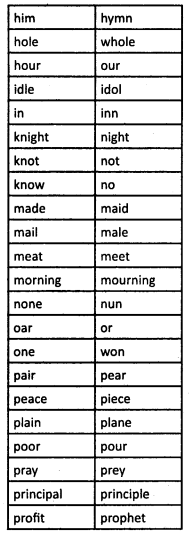

Homonyms:
- The book that we read and the ticket that we book.
- Bank where we keep money and the bank of a river
- Block of a building and to block a road
- Bow and arrow and bow in respect
- Change for 500 Rupees and to change clothes
- A fine example and the fine for delayed payment
- Gross (crude) behaviour and gross salary
- Jam to eat and traffic jam
- Left side and leftover food
- A light that shines and weight that is light
- Match to be played and the blouse to match the skirt
- Park to relax and vehicle to park
- Right side and the right thing to do
- Row in a classroom and the row of a boat
- Spring as a season and the spring of water.
Babar Ali (World’s Youngest Headmaster making remarkable changes in India) by Samarpita Mukherjee Sharma A Note on the Author:
Samarpita Mukherjee Sharma is the Associate Creative Editor of ‘Youth Leader India’, the India Chapter of Youth Leader Magazine. She is a member of the dynamic, action-oriented online magazine network focusing on ground-breaking positive change initiatives, portraits, tools and more.
Babar Ali Summary in English
In the lesson ‘Babar Ali’, Samarpita Mukherjee Sharma introduces to the readers the world’s youngest headmaster – Babar Ali – through the words of Tanvir, a Youth Leader volunteer. Our pride lies in the fact that this sixteen-year-old headmaster is an Indian, hailing from Murshidabad in West Bengal. Babar Ali’s father Nasiruddin Sheikh, a jute seller, though uneducated, believed in the idea that education is man’s true religion and sent Babar to school. Babar, a first-generation learner, was a model student in school.
But, what he did after school was more significant than being studious or smart. With the awareness that he was one of the few fortunate boys in the village, Babar was prompted to do something for his fellow youngsters who did not enjoy the same privilege. That is why, after his school hours, in the backyard of his house, in the open air, he started teaching the children who wanted to learn, but had no opportunity to do so and were deprived of their basic right to education.
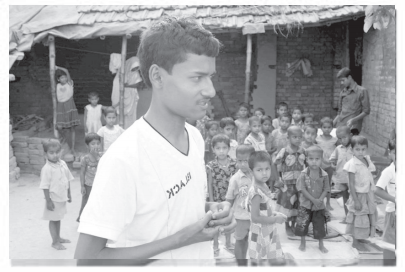
Even if the government-aided education was free, the other expenses incurred over the uniform, books, etc., discouraged parents from sending their children to school. Hence, the children ended up us maidservants, mechanics, day labourers, grass cutters, livestock herders etc. Babar Ali’s vision for these children was different. He wanted to teach these children who were prepared to walk for miles to learn. Thus came into being ‘Anand Siksha Niketan’. In fact, the school started as a game and soon turned into a serious pursuit because children enjoyed learning arithmetic. An institution that came into being with just eight children and one young headmaster, to begin with, in nine years time, had 60 regular attendees, 10 volunteer teachers, 200 students on roll-call and 800 students in total. Fortunately, the school had benefactors in teachers, IAS officers, social workers and religious leaders.
To top it all, even the West Bengal government recognised the school. But, one should remember that the real strength of the school lay in the selfless service of simple people like Tulu Rani Hazra, an illiterate fishmonger, who encouraged parents to send their children to school; Debarita, a college-going teenager, who had the noble desire to help the underprivileged of society by being their teacher. The strength of the school also lay in the.fact that all teacher volunteers were students who used their free time productively to teach the less fortunate, and the fact that they were not very senior to the students helped them in getting the attention of their pupils.
Thus, we see that the efforts of a single boy resulted in almost a revolution in the field of education and made people believe in the ideal that common people can achieve uncommon feats.
Babar Ali Summary in Kannada
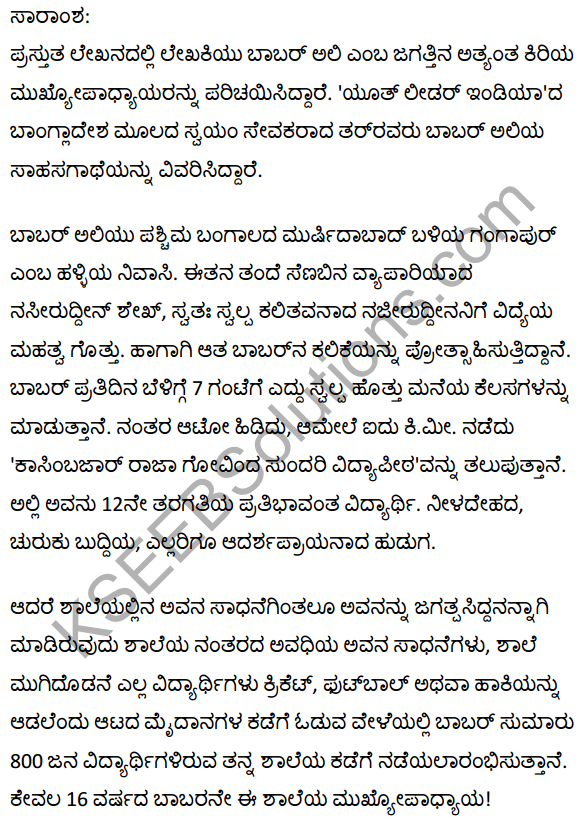
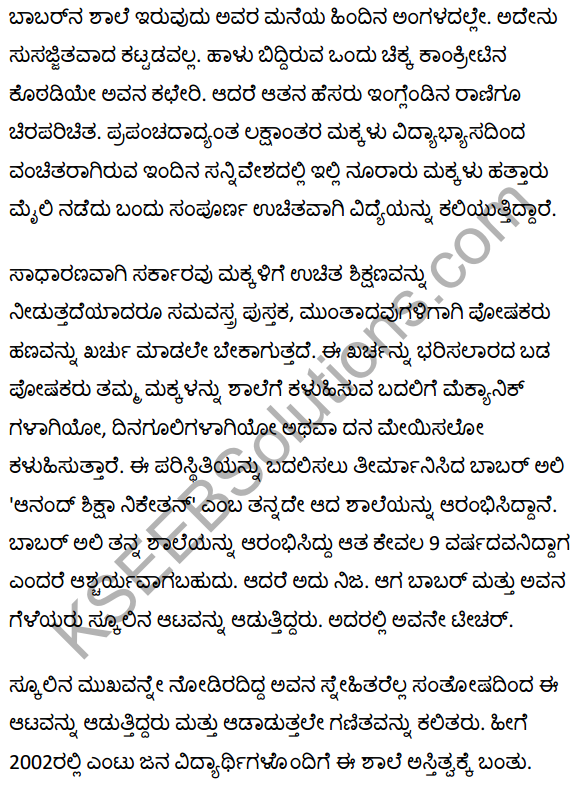

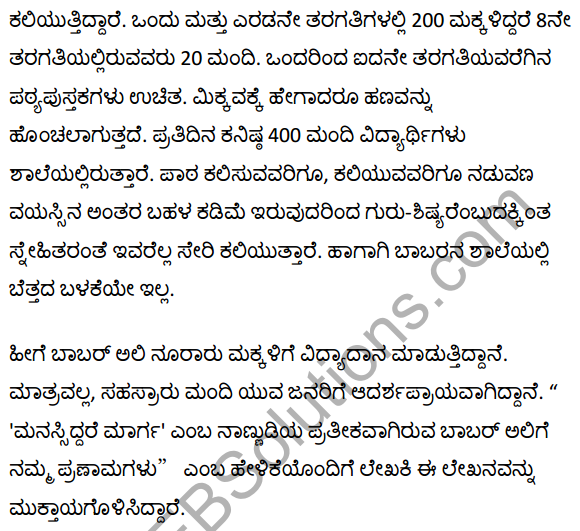
Glossary:
- gangly (adj): tall, thin and awkward in one’s movements
- intrigue (v): to make somebody very interested and want to know about something
- crusading (adj): pertaining to a long and determined effort
Hope you love the Karnataka 1st PUC English Chapter Wise Material. Clearly understand the deep concept of English learning with the help of KTBS 1st PUC English Chapter 6 Babar Ali PDF. Refer your friends to and bookmark our website for instant updates. Also, keep in touch with us using the comment section.